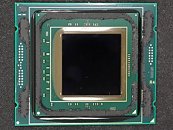Mar 31st, 2025 05:30 EDT
change timezone
Latest GPU Drivers
New Forum Posts
- Technical Issues - TPU Main Site & Forum (2025) (83)
- TPU's Rosetta Milestones and Daily Pie Thread (2263)
- Can you guess Which game it is? (36)
- i5 14600K or i7 14700K? (9)
- Windows 10 Vs 11, Which one too choose? (129)
- The TPU UK Clubhouse (26016)
- 5070 Ti power limit questions (26)
- Your PC ATM (35311)
- Future-proofing my OLED (83)
- AMD RX 9070 XT & RX 9070 non-XT thread (OC, undervolt, benchmarks, ...) (72)
Popular Reviews
- Sapphire Radeon RX 9070 XT Pulse Review
- ASRock Phantom Gaming B850 Riptide Wi-Fi Review - Amazing Price/Performance
- Samsung 9100 Pro 2 TB Review - The Best Gen 5 SSD
- Palit GeForce RTX 5070 GamingPro OC Review
- Sapphire Radeon RX 9070 XT Nitro+ Review - Beating NVIDIA
- Assassin's Creed Shadows Performance Benchmark Review - 30 GPUs Compared
- Enermax REVOLUTION D.F. 12 850 W Review
- AMD Ryzen 7 9800X3D Review - The Best Gaming Processor
- ASRock Radeon RX 9070 XT Taichi OC Review - Excellent Cooling
- XPG LEVANTE II 360 Review
Controversial News Posts
- AMD RDNA 4 and Radeon RX 9070 Series Unveiled: $549 & $599 (260)
- MSI Doesn't Plan Radeon RX 9000 Series GPUs, Skips AMD RDNA 4 Generation Entirely (142)
- Microsoft Introduces Copilot for Gaming (124)
- AMD Radeon RX 9070 XT Reportedly Outperforms RTX 5080 Through Undervolting (119)
- NVIDIA Reportedly Prepares GeForce RTX 5060 and RTX 5060 Ti Unveil Tomorrow (115)
- Over 200,000 Sold Radeon RX 9070 and RX 9070 XT GPUs? AMD Says No Number was Given (100)
- NVIDIA GeForce RTX 5050, RTX 5060, and RTX 5060 Ti Specifications Leak (96)
- Retailers Anticipate Increased Radeon RX 9070 Series Prices, After Initial Shipments of "MSRP" Models (90)
News Posts matching #4.8 GHz
Return to Keyword Browsing
Intel Xeon W9-3595X Spotted with 60 Cores, 112 MB of L3 Cache, and 4.60 GHz Frequency
Intel's upcoming high-end desktop (HEDT) processor lineup for enthusiasts and prosumers is around the corner, and today, we managed to see the flagship SKU - the Xeon W9-3595X. Spotted recently on Geekbench benchmarks, this new chip packs a whopping 60 cores and 120 threads, making it Intel's highest core count HEDT offering yet. The Xeon W9-3595X is based on Intel's advanced Sapphire Rapids architecture, built using the Intel 7 process node. It succeeds the previous flagship 56-core W9-3495X, with four additional cores crammed into the new 350 Watt TDP envelope. Clock speeds have taken a slight hit to accommodate the extra cores, with the maximum turbo frequency lowered from 4.8 GHz on the 3495X to 4.6 GHz on the new 3595X.
However, with more cores, the 3595X should still offer a significant multi-threaded performance uplift for heavily parallel workloads. The Xeon W9-3595X will drop into existing LGA-4677 motherboards, like the ASUS PRO WS 790-ACE, after a BIOS update. It features 112 MB of L3 cache, 120 MB of L2 cache (2 MB per core), and continues Intel's push towards higher core counts for enthusiasts, content creators, and workstation users who need maximum multi-threaded horsepower. Pricing and availability details remain unannounced as of now. But with an appearance on public databases, an official launch of the 60-core HEDT juggernaut seems imminent. These new Sapphire Rapids SKUs will likely have extra AI features, like dedicated AI acceleration engines, in the same manner that server-class SKUs do.
However, with more cores, the 3595X should still offer a significant multi-threaded performance uplift for heavily parallel workloads. The Xeon W9-3595X will drop into existing LGA-4677 motherboards, like the ASUS PRO WS 790-ACE, after a BIOS update. It features 112 MB of L3 cache, 120 MB of L2 cache (2 MB per core), and continues Intel's push towards higher core counts for enthusiasts, content creators, and workstation users who need maximum multi-threaded horsepower. Pricing and availability details remain unannounced as of now. But with an appearance on public databases, an official launch of the 60-core HEDT juggernaut seems imminent. These new Sapphire Rapids SKUs will likely have extra AI features, like dedicated AI acceleration engines, in the same manner that server-class SKUs do.

Intel Core Ultra 7 155H iGPU Outperforms AMD Radeon 780M, Comes Close to Desktop Intel Arc A380
Intel is slowly preparing to launch its next-generation Meteor Lake mobile processor family, dropping the Core i brand name in favor of Core Ultra. Today, we are witnessing some early Geekbench v6 benchmarks with the latest leak of the Core Ultra 7 155H processor, boasting an integrated Arc GPU featuring 8 Xe-Cores—the complete configuration expected in the GPU tile. This tile is also projected to be a part of the more potent Core 9 Ultra 185H CPU. The Intel Core Ultra 7 155H processor has been benchmarked in the new ASUS Zenbook 14, which houses a 16-core and 22-thread hybrid CPU configuration capable of boosting up to 4.8 GHz. Paired with 32 GB of memory, the configuration was well equipped to supply CPU and GPU with sufficient memory space.
Perhaps the most interesting information from the submission was the OpenCL score of the GPU. Clocking in at 33948 points in Geekbench v6, the GPU is running over AMD's Radeon 780M GPU found in APU solutions like AMD Ryzen 9 7940HS and Ryzen 9 7940U, which scored 30585 and 27345 points in the same benchmark, respectively. The GPU tile is millimeters away from closing the gap between itself and the desktop Intel Arc A380 discrete GPU, which scored 37105 points for less than a 10% difference. The Xe-LPG GPU version is bringing some interesting performance points for the integrated GPU platform, which means that Intel's Meteor Lake SKUs will bring more performance/watt than ever.
Perhaps the most interesting information from the submission was the OpenCL score of the GPU. Clocking in at 33948 points in Geekbench v6, the GPU is running over AMD's Radeon 780M GPU found in APU solutions like AMD Ryzen 9 7940HS and Ryzen 9 7940U, which scored 30585 and 27345 points in the same benchmark, respectively. The GPU tile is millimeters away from closing the gap between itself and the desktop Intel Arc A380 discrete GPU, which scored 37105 points for less than a 10% difference. The Xe-LPG GPU version is bringing some interesting performance points for the integrated GPU platform, which means that Intel's Meteor Lake SKUs will bring more performance/watt than ever.

Intel Core i7 8700K Reportedly Reaches 4.8 GHz Easily, 5 GHz+ Requires Delid
A report out of Expreview says that users should expect Intel's 8700K 6-core processor to easily clock up to 4.8 GHz with conventional cooling methods. Apparently, the chip doesn't even need that much voltage to achieve this feat either; however, thermal constraints are quickly hit when pushing Intel's latest (upcoming) leader for the mainstream desktop parts. Expreview says that due to the much increased temperatures, users who want to eke out the most performance from their CPU purchase will likely have to try and resort to delidding of their 8700K. While that likely wouldn't have been necessary with Intel's 7700K processors, remember that here we have two extra CPU cores drawing power and producing waste heat, so it makes sense that thermals will be a bigger problem.
This is understandable: Intel is still using their much chagrined (and divisive) TIM as a heat conductor between the CPU die and the CPU's IHS (Integrated Heat Spreader), which has been proven to be a less than adequate way of conducting said heat. However, we all knew this would be the case; remember that Intel's HEDT HCC processors also feature this TIM, and in that case, we're talking of up to 18-core processors that can cost up to $1,999 - if Intel couldn't be bothered to spend the extra cents for actual solder as an interface material there, they certainly wouldn't do so here. As with almost all peeks at as of yet unreleased products, take this report (particularly when it comes to frequencies, as each CPU overclocks differently) with a grain of salt, please.
This is understandable: Intel is still using their much chagrined (and divisive) TIM as a heat conductor between the CPU die and the CPU's IHS (Integrated Heat Spreader), which has been proven to be a less than adequate way of conducting said heat. However, we all knew this would be the case; remember that Intel's HEDT HCC processors also feature this TIM, and in that case, we're talking of up to 18-core processors that can cost up to $1,999 - if Intel couldn't be bothered to spend the extra cents for actual solder as an interface material there, they certainly wouldn't do so here. As with almost all peeks at as of yet unreleased products, take this report (particularly when it comes to frequencies, as each CPU overclocks differently) with a grain of salt, please.
Mar 31st, 2025 05:30 EDT
change timezone
Latest GPU Drivers
New Forum Posts
- Technical Issues - TPU Main Site & Forum (2025) (83)
- TPU's Rosetta Milestones and Daily Pie Thread (2263)
- Can you guess Which game it is? (36)
- i5 14600K or i7 14700K? (9)
- Windows 10 Vs 11, Which one too choose? (129)
- The TPU UK Clubhouse (26016)
- 5070 Ti power limit questions (26)
- Your PC ATM (35311)
- Future-proofing my OLED (83)
- AMD RX 9070 XT & RX 9070 non-XT thread (OC, undervolt, benchmarks, ...) (72)
Popular Reviews
- Sapphire Radeon RX 9070 XT Pulse Review
- ASRock Phantom Gaming B850 Riptide Wi-Fi Review - Amazing Price/Performance
- Samsung 9100 Pro 2 TB Review - The Best Gen 5 SSD
- Palit GeForce RTX 5070 GamingPro OC Review
- Sapphire Radeon RX 9070 XT Nitro+ Review - Beating NVIDIA
- Assassin's Creed Shadows Performance Benchmark Review - 30 GPUs Compared
- Enermax REVOLUTION D.F. 12 850 W Review
- AMD Ryzen 7 9800X3D Review - The Best Gaming Processor
- ASRock Radeon RX 9070 XT Taichi OC Review - Excellent Cooling
- XPG LEVANTE II 360 Review
Controversial News Posts
- AMD RDNA 4 and Radeon RX 9070 Series Unveiled: $549 & $599 (260)
- MSI Doesn't Plan Radeon RX 9000 Series GPUs, Skips AMD RDNA 4 Generation Entirely (142)
- Microsoft Introduces Copilot for Gaming (124)
- AMD Radeon RX 9070 XT Reportedly Outperforms RTX 5080 Through Undervolting (119)
- NVIDIA Reportedly Prepares GeForce RTX 5060 and RTX 5060 Ti Unveil Tomorrow (115)
- Over 200,000 Sold Radeon RX 9070 and RX 9070 XT GPUs? AMD Says No Number was Given (100)
- NVIDIA GeForce RTX 5050, RTX 5060, and RTX 5060 Ti Specifications Leak (96)
- Retailers Anticipate Increased Radeon RX 9070 Series Prices, After Initial Shipments of "MSRP" Models (90)




